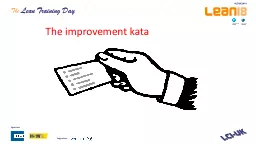

No planned alarms Safety exit Through the door To the left Down the stairs Take the left door out Muster point on parking lot behind the building Safety number 0529 3 64000 Footer ID: 814642
Download The PPT/PDF document "The improvement kata hse" is the property of its rightful owner. Permission is granted to download and print the materials on this web site for personal, non-commercial use only, and to display it on your personal computer provided you do not modify the materials and that you retain all copyright notices contained in the materials. By downloading content from our website, you accept the terms of this agreement.
Slide1
The
improvement kata
Slide2hseNo planned alarms! Safety exit: Through the door,To the left,Down the stairs,Take the left door out, Muster point on parking lot behind the buildingSafety number: 0529 – 3 64000
Footer
Slide3goalUnderstand:principles of the Improvement Katahow to apply the Improvement Kata with a team
p
itfalls
and how to overcome
them
And get
to know a number of colleagues who are engaged in lean or continuous improvement in Shell/ NAM or one of their ISC’s.
Footer
Slide4HowInformationPractical exercises Group discussion on real life cases
Footer
Slide5resultYou can lead teams to make step by step process improvements, enabling the business to reach the Hoshin 2015: 1,000 Flowing Wells for less than 1 billion €
Footer
Slide6programIntroductionsThe Improvement Kata – background and principlesExerciseLUNCH
Applying the Improvement Kata in your part of the organization
After Action Review and Follow up
Footer
Slide7introductionsIntroduce yourself, stating your name, role and location. Then: What was your last improvement step?What did you expect? What actually happened? What did you learn?
Footer
Slide8Footer
The improvement
kata
is like going to the top…
Slide9Wat zit er aan de andere kantFooter
Slide1010/29/18www.heyunka.com
10
Slide11Question 1We will roll a die three (3) times and sum the numbers. The sum will be a number between 3 and 18. Before we roll, please write down: What will be the sum of the three rolls?
Footer
Slide12Those of you who wrote down the incorrect sum…How do you feel? Footer
Slide13Footer
Slide14Question 2 What will be the next number in this series? Please write down your answer.
Footer
2, 4, 6, 8, 10, 12, …
Slide15Question 2Those of you who wrote down the incorrect number… How do you feel this time? Footer
2, 4, 6, 8, 10, 12,
2
Slide16Footer
Slide17the improvement process
Slide18We’re Surrounded by problems…
Slide19From firefighting to improving
Slide20Understand the direction of the company
Slide21And of your team
Slide22Set a first next target condition
Slide23Then: Plan – do - check - adjust
Slide24Plan – do - check - adjust
Slide25Single piece flow is better for individual workFooter A 1B 2C 3
D 4
E 5 I
F 6 II
G 7 III
…
…N 14 X0 15P 16Q 17
…
…
Z 26
3 products:
ABC … Z
123 … 26
Emergencies:
I, II, III, IV, V, VI, VII, VIII, IX, X
Slide26Single piece flow is better for TeamsFooter
Slide27What’s the vision?Footer
Slide28What’s the hoshin?Footer
Slide29What’s the target condition of your team?Footer
Slide30kata10/29/18
www.heyunka.com
30
Slide311. What’s the next target condition? Key points: Include both a target and a conditionThe Next Target Condition is a process improvement
Understand
the link with our target condition,
hoshin
and vision.
Ambitious
Avoid
analysis paralysis
User
story format (optional)
SMART
(optional)
Footer
Slide32Make use of lean principlesFooter
Slide332. What’s the current condition now?Key points: Make use of your Lean or Six Sigma Toolbox, in order to determine how you’re doing now: demand analysis, VSM,
spaghetti
diagrams,
fishbones
, etc.
Limit
yourself to the process as it is relevant for reaching the target condition.
Footer
Slide34Make use of lean toolsFooter
Slide353. What obstacles are preventing you from reaching the target condition now? Key Points: Follow brainstorming rules: All perceived obstacles are ok, no arguing, no priorities. If needed: Make use of TIM WOOD to identify waste.
Footer
Slide36Waste are obstacles10/29/1836
OVERPROCESSING
SEARCHING
OVERPRODUCTION
HANDOVERS
WAITING
MOVEMENT
REWORK
TALENT
Slide374. What is the first next obstacle you will be working on? Key points: Choose only one obstacle to work on first.
Make
sure to start change today
No
lists and action plans
Make
sure to focus on 1 thing only
S tick
to your circle of influence
Make
sure to have the right people in your team
Go step
by step
Think
about the evaluation of each step
When
done choose a next obstacle
Footer
Slide385. When do we see the results of that? Define a period as
short
as
possible
Footer
Slide39LEAN CI PORTAL & BLOGFooter
Slide40Yammer! For ONEgas: Thanks for posting your learnings on the ONEgas Yammer Pages! Footer
Slide41Slide42Kata a3
Improvement
Kata
A3
Process:
Hoshin:1000 flowing wells for < 1 bjn
TC Date:
Next Target Condition
PDCA
Date:
Obstacle:
Obstacle or step
What did you expect
What happened?
Learned?
Current Condition
Progress Graph
Obstacle Parking Lot